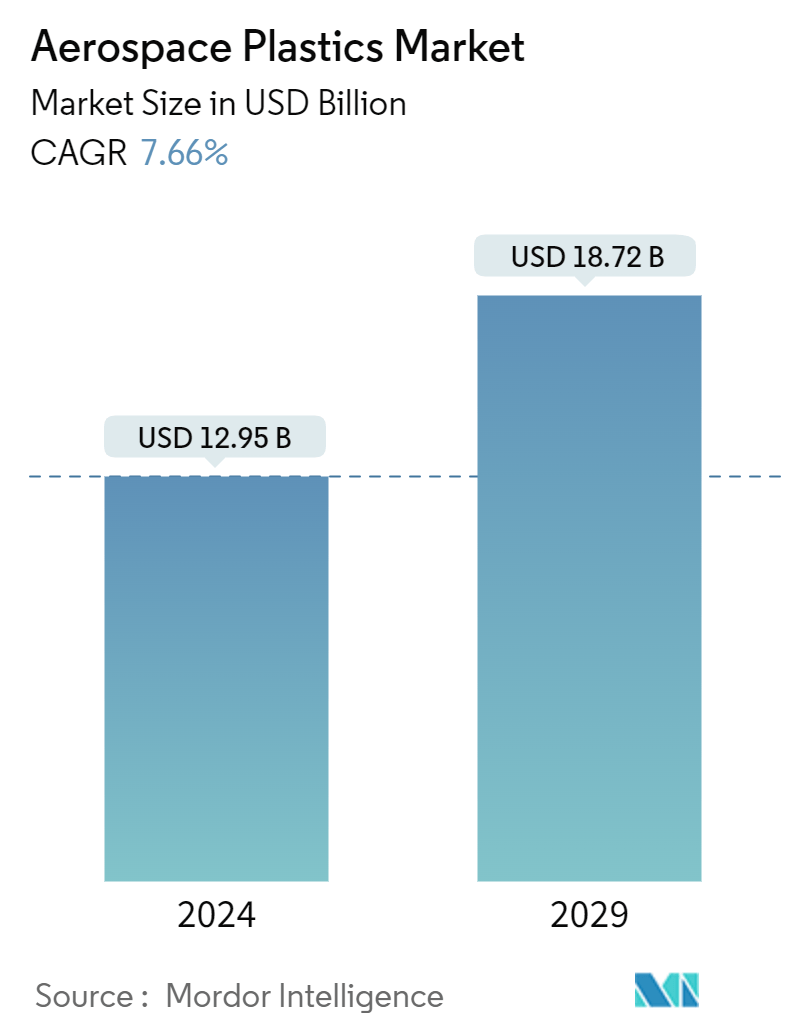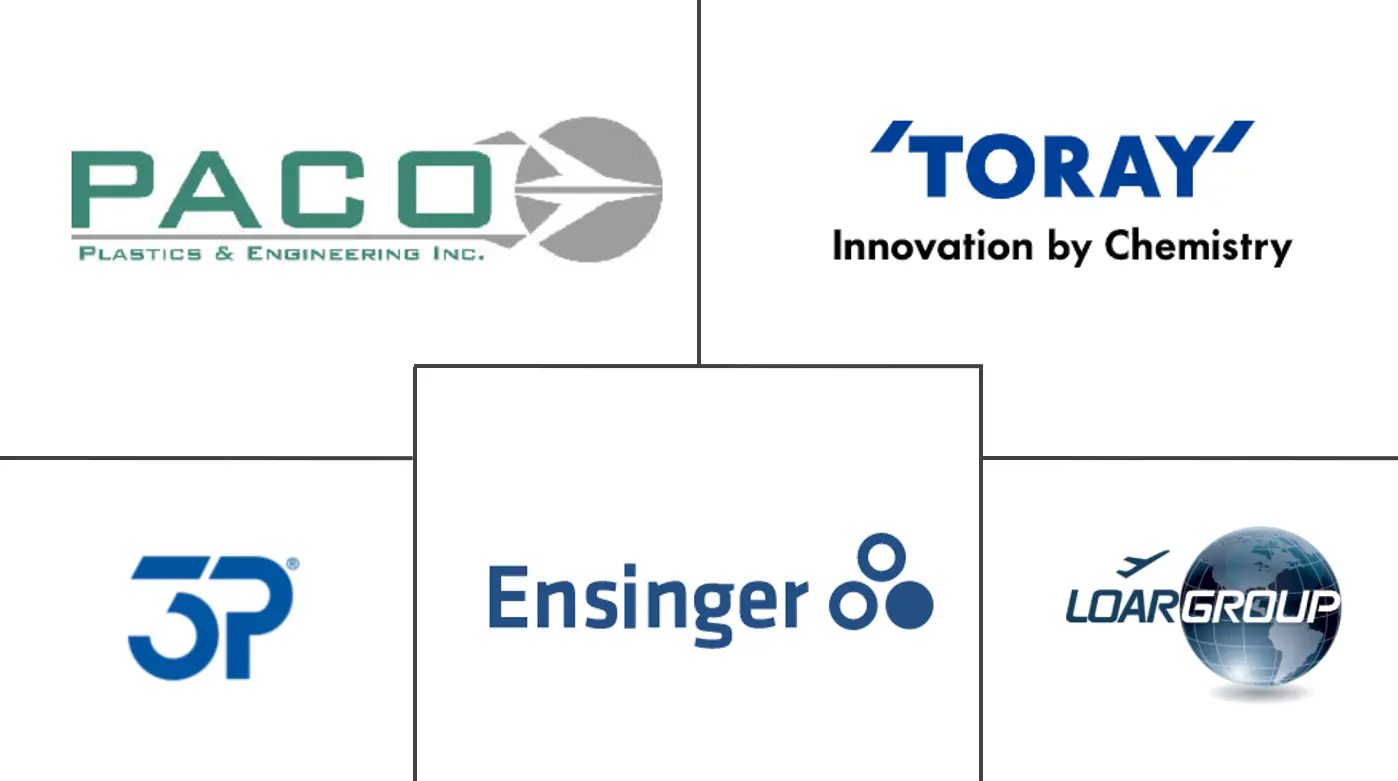Market Size of Aerospace Plastics Industry

| Study Period | 2019 - 2029 |
| Market Size (2024) | USD 12.95 Billion |
| Market Size (2029) | USD 18.72 Billion |
| CAGR (2024 - 2029) | 7.66 % |
| Fastest Growing Market | Asia Pacific |
| Largest Market | Europe |
| Market Concentration | Low |
Major Players
*Disclaimer: Major Players sorted in no particular order |
Aerospace Plastics Market Analysis
The Aerospace Plastics Market size is estimated at USD 12.95 billion in 2024, and is expected to reach USD 18.72 billion by 2029, growing at a CAGR of 7.66% during the forecast period (2024-2029).
Plastics are lightweight and highly durable and are used as an alternative to aluminum and steel components, increasing their share in the overall structure of an airplane. The increasing demand for plastics in several aerospace applications, including cabin interiors, structural components, electrical electronics & control panels, windows, windshields, and canopies, is expected to drive the demand for aerospace plastics materials over the years. The market is driven by the increasing demand for new aircraft as part of the fleet expansion and modernization programs initiated by respective end-users in the military, commercial, general aviation, and space sectors.
Aerospace-grade plastics must adhere to several regulations and specifications, such as UL94, FAR 25.853, ASTM, DFAR, MIL-PRF-5425, MIL-PRF-8184, and MIL-PRF-25690. The stringent standards lead to high R&D costs, thereby limiting the participation of new players needing more technical expertise to produce aerospace-grade plastics.
Aerospace Plastics Industry Segmentation
In an aircraft, plastic is typically used for interior applications, such as air ducts, cabin partitions, floor panels, and overhead luggage bins. Plastics are also used on aircraft structural components, including wing ribs and spars, fuel tank covers, landing gear hubcaps, pylon fairings, and radomes. In addition, plastics are used to design and manufacture avionics sensor plates, electronic component mounting brackets, and ventilation impeller blades. Also, plastics are widely used in spacecraft construction for plastic seals, flooring, seating, and instrumentation panels.
The aerospace plastics market is segmented based on end-user, application, and geography. By end-user, the market is segmented into aviation and space. By application, the market is segmented into aerostructure, cabin interiors, propulsion systems and satellites. The report also covers the market sizes and forecasts for the aerospace plastics market in major countries across different regions. The market size is provided for each segment in terms of value (USD).
| End-user | ||||||
| ||||||
| Space |
| Application | |
| Aerostructure | |
| Cabin Interiors | |
| Propulsion Systems | |
| Satellites |
| Geography | |||||||
| |||||||
| |||||||
| |||||||
| |||||||
|
Aerospace Plastics Market Size Summary
The aerospace plastics market is poised for significant growth, driven by the increasing demand for lightweight and durable materials that serve as alternatives to traditional metals like aluminum and steel in aircraft construction. This shift is largely due to the need for enhanced fuel efficiency and performance in modern aircraft, as well as the expanding applications of plastics in various aerospace components such as cabin interiors, structural elements, and electronic panels. The market's expansion is further fueled by the global rise in air travel, particularly in regions like Europe, where low-cost airlines are proliferating. These airlines often opt for narrow-body aircraft, which require extensive use of plastics for cabin interiors, thereby boosting market demand. The aerospace plastics industry is characterized by stringent regulatory standards, which, while ensuring safety and performance, also pose challenges for new entrants due to high research and development costs.
The market landscape is fragmented, with key players like Paco Plastics, Inc., 3P Performance Plastics Products, Loar Group, Inc., Ensinger GmbH, and Toray Industries, Inc. actively investing in advanced materials and technologies to meet the evolving needs of the aerospace sector. Recent strategic moves, such as Demgy Group's acquisition of E.I.S. Aircraft GmbH, highlight the industry's focus on consolidating capabilities and enhancing regional leadership in high-value-added plastics and composites. Additionally, significant investments, such as Toray Industries' commitment to increasing carbon fiber production capacity, underscore the industry's dedication to supporting the aerospace sector's transition towards more sustainable and efficient aircraft designs. Despite the promising growth prospects, the market faces challenges related to economic fluctuations, technological transfers, and the cyclical nature of aerospace demand, which can impact revenue stability for manufacturers.
Aerospace Plastics Market Size - Table of Contents
-
1. MARKET DYNAMICS
-
1.1 Market Overview
-
1.2 Market Drivers
-
1.3 Market Restraints
-
1.4 Porter's Five Forces Analysis
-
1.4.1 Threat of New Entrants
-
1.4.2 Bargaining Power of Buyers
-
1.4.3 Bargaining Power of Suppliers
-
1.4.4 Threat of Substitute Products
-
1.4.5 Intensity of Competitive Rivalry
-
-
-
2. MARKET SEGMENTATION
-
2.1 End-user
-
2.1.1 Aviation
-
2.1.1.1 Military Aircraft
-
2.1.1.2 Commercial and Freighter Aircraft
-
2.1.1.3 Helicopters
-
2.1.1.4 General Aviation
-
-
2.1.2 Space
-
-
2.2 Application
-
2.2.1 Aerostructure
-
2.2.2 Cabin Interiors
-
2.2.3 Propulsion Systems
-
2.2.4 Satellites
-
-
2.3 Geography
-
2.3.1 North America
-
2.3.1.1 United States
-
2.3.1.2 Canada
-
-
2.3.2 Europe
-
2.3.2.1 United Kingdom
-
2.3.2.2 France
-
2.3.2.3 Germany
-
2.3.2.4 Russia
-
2.3.2.5 Rest of Europe
-
-
2.3.3 Asia-Pacific
-
2.3.3.1 China
-
2.3.3.2 India
-
2.3.3.3 Japan
-
2.3.3.4 South Korea
-
2.3.3.5 Rest of Asia-Pacific
-
-
2.3.4 Latin America
-
2.3.4.1 Brazil
-
2.3.4.2 Rest of Latin America
-
-
2.3.5 Middle East and Africa
-
2.3.5.1 Saudi Arabia
-
2.3.5.2 United Arab Emirates
-
2.3.5.3 Turkey
-
2.3.5.4 Rest of Middle East and Africa
-
-
-
Aerospace Plastics Market Size FAQs
How big is the Aerospace Plastics Market?
The Aerospace Plastics Market size is expected to reach USD 12.95 billion in 2024 and grow at a CAGR of 7.66% to reach USD 18.72 billion by 2029.
What is the current Aerospace Plastics Market size?
In 2024, the Aerospace Plastics Market size is expected to reach USD 12.95 billion.

